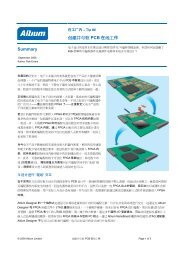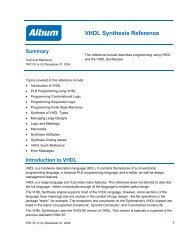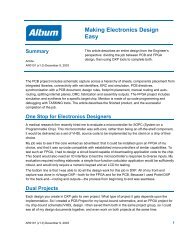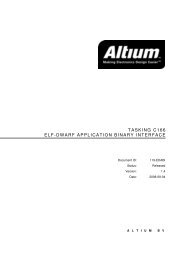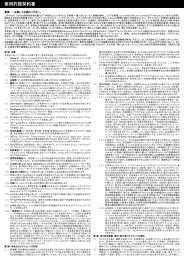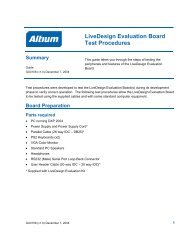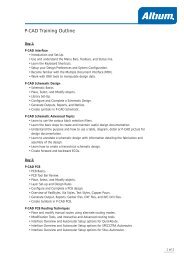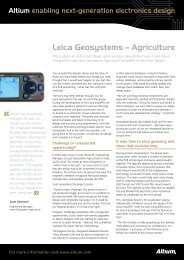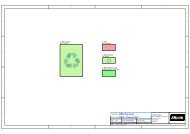You also want an ePaper? Increase the reach of your titles
YUMPU automatically turns print PDFs into web optimized ePapers that Google loves.
<strong>Moving</strong> <strong>to</strong> <strong>Altium</strong> <strong>Designer</strong> <strong>From</strong> OrCAD<br />
users <strong>to</strong> determine how they want their junctions <strong>to</strong> import, and also log any errors or warnings that you<br />
can check later after importing.<br />
Defining net connectivity, net identifiers, scoping and how it all relates <strong>to</strong> multi-sheet design is a<br />
must read for OrCAD users and is fully explained in Connectivity and Multi-Sheet Design.<br />
Design synchronization<br />
Design synchronization is fully integrated in <strong>Altium</strong> <strong>Designer</strong> without the need for passing a net list.<br />
Synchronization in <strong>Altium</strong> <strong>Designer</strong> is also bi-directional, allowing you <strong>to</strong> make annotation changes and<br />
component property updates in both directions between your schematic and PCB, in a single<br />
operation.<br />
Again, an important and fundamental premise of <strong>Altium</strong> <strong>Designer</strong> is that the setup of the design's<br />
connectivity is driven from the schematic through <strong>to</strong> the PCB. If you are making connectivity changes in<br />
the opposite direction (from PCB <strong>to</strong> Schematic), a report is generated and these updates can then be<br />
performed on the schematic.<br />
The synchronization feature is used when you first transfer from the schematic <strong>to</strong> the new blank board,<br />
or when you make design changes that need <strong>to</strong> be passed over.<br />
For more information on design transfer and design synchronization, read the article Finding<br />
Differences and Synchronizing Designs.<br />
As well as being able <strong>to</strong> detect electrical differences, such as changed designa<strong>to</strong>rs, component values<br />
or net connectivity, <strong>Altium</strong> <strong>Designer</strong> also include a physical difference engine, which can find schematic<br />
and PCB layout changes – ideal for examining changes between different revisions of a board.<br />
Complex Hierarchy<br />
Complex hierarchy is the general term used throughout the industry <strong>to</strong> describe the process of using<br />
multiple instances of the same sheet in a schematic hierarchy. This important concept is supported by<br />
<strong>Altium</strong> <strong>Designer</strong> as well as OrCAD.<br />
Multi-channel design<br />
Traditionally, a design that included complex hierarchy had <strong>to</strong> go through a process of ‘flattening’ or<br />
‘expanding’ the hierarchy at some point, <strong>to</strong> uniquely instantiate every component and net. <strong>Altium</strong><br />
<strong>Designer</strong> does not need <strong>to</strong> do this, so this multiple-instantiation capability is referred <strong>to</strong> as multichannel<br />
design instead of complex hierarchy.<br />
Like complex hierarchy, multi-channel design is the ability <strong>to</strong> reference a child sheet multiple times. It<br />
can be done by placing multiple sheet symbols, each referencing the same sub-sheet, or it can be<br />
done by placing a single sheet-symbol and using the Repeat statement <strong>to</strong> generate an array of subsheets.<br />
This is built on the complex hierarchy architecture of multiple instances, but in this case the<br />
parent object is expanded by the design compiler at the time of compilation (discussed below).<br />
Multi-channel design also supports multiple levels. For example, a 32-channel design could be<br />
structured over two levels, having 4-banks of 8-channels, <strong>to</strong> create the final 32-channels. Additionally<br />
you can wire signals <strong>to</strong> either all of the channels or use a bus where one member of the bus goes <strong>to</strong><br />
each channel. <strong>Altium</strong> <strong>Designer</strong> is the only electronic design platform <strong>to</strong> offer this concept.<br />
There are several example multi-channel designs that come with <strong>Altium</strong> <strong>Designer</strong> that you may<br />
wish <strong>to</strong> look at. These include the Multi-Channel Mixer, Peak Detec<strong>to</strong>r and PortSwitcher, all three<br />
AP0132 (v2.1) February 21, 2006 11



